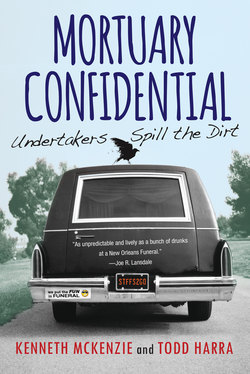Читать книгу Mortuary Confidential - Kenneth McKenzie - Страница 11
На сайте Литреса книга снята с продажи.
PART I First Calls and Removals
ОглавлениеWhen a death happens, the family contacts the neighborhood funeral home. This initial report of the death is known in the profession as the “first call.” Soon after it, the remains of the dearly departed are removed from the place of death and brought back to the mortuary for preparation. Unfortunately, the dead have no sense of time; they pass from this life to eternity at all hours of the day and night. And we, the undertakers, are often summoned out of deep sleep, away from the dinner table, and out of the shower, sometimes in bitterly cold weather, to perform the removal.
When we start in this business, we generally exchange an apprenticeship for being on call for the firm. Consequently, the apprentice is usually the one to take the first call and make the removal. The apprentice can sometimes have a difficult job. Depending on the company, the hours can be long and relentless. But as in every other business, you have to start at the bottom. Typically, as you’ll see illustrated in several stories throughout the book, apprentices are given an apartment in the funeral home while they serve their tenure.
In the 19th and early 20th centuries, most removals were made from the home. Some of the old-timers I work with can remember some of the old-timers they worked with who would embalm people right in their beds (by a method called gravity injection) and then make the funeral arrangements at the kitchen table with the family, usually with a bottle of spirits in the middle of the table. This was back when people were laid out in the parlors of their homes on cooling boards, and the wakes would be big social events. An old family friend, who isn’t an undertaker, likes to tell me about helping one of the local morticians in the ’40s, doing removals using wicker baskets instead of the stretchers we now use. Interestingly enough, that is rumored to be where the term “basket case” comes from. Things have changed since then. Bodies are prepared at the funeral home, and most wakes are held at the funeral home or church.
As America shifted from a predominately rural, agrarian society to an urban, industrial/technology-based nation, the sick and dying were shifted from the home to institutional care. Nowadays, most removals are made from hospitals and nursing facilities. Thanks to the emergence of the hospice program, there seems to be a rising number of home deaths. People can once again die at home, in their bed, surrounded by loved ones.
The stories in this section include house calls as well as removals from hospitals/nursing facilities—both of which, as you’ll see, can present some…interesting challenges.
